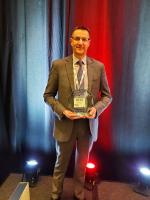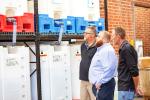CHICAGO — Health concerns, in the form of emerging or increasing pathogens, have always been a public concern.
When these scares take place, laundry operations need to ensure that how they are processing goods results in clean, hygienic linens.
However, the past few years with the pandemic and then monkeypox have shined a spotlight on the laundry and linen services industry, and this has caused everyone to use a microscope on operations’ wash chemistry.
American Laundry News communicated with five chemical company representatives (Jack Heaviside, senior consultant-specialty markets for Sunburst Chemicals; Chad Dare, executive vice president of sales, Pariser Industries; Graham Skinner, vice president of business development and technical support for UNX-Christeyns; Annie Thomas, Ecolab’s senior marketing communications manager; and Leonardo Gastelum, national accounts director for Norchem Corp.) to find out how laundry chemistry has changed and what operators need to know and do today.
Has anything changed regarding what laundry employees need to know about chemistry? If so, what?
HEAVISIDE: No, for a short answer. Expanding on the importance of knowledge should be a continual process.
DARE: Employees are on the front line with regard to effective washroom chemistry. Being aware of product inventory and proper container placement sounds simple but is essential and often overlooked or done wrong.
Being aware of and employing proper wash procedures (such as soiled linen loading/good washer utilization, selecting correct wash formulae, separating soil linens and stain handling) are employees’ responsibilities once informed, and they need to be held accountable by supervisors.
As always, employees should understand the purpose of the chemicals on hand, and be in-serviced on safety of handling, replacement and spill remediation, to include in-service review of safety data sheets (SDS) on a recurring basis.
THOMAS: Yes, the emergence of COVID-19 and other health concerns has necessitated a deeper understanding of chemistry among laundry employees.
They now need to be well-versed in disinfection chemistry, safe chemical handling, and the science behind the products used in laundry processes. Ecolab provides comprehensive training programs to ensure employees possess the knowledge required to optimize chemistry use.
How has chemistry training for employees changed? How can a service best ensure thorough, proper training?
HEAVISIDE: The biggest issue for chemicals is proper training on how to safely use them. Recurring training on how to transfer these products into day tanks, monitoring inventory levels became a huge issue as labor was stretched.
Post-pandemic, these problems are persisting. Our advice is to have a robust safety committee and review the plant safety plan quarterly. Inspect what you expect as a manager and don’t count on a verbal response as the end of the discussion. Most chemical mishaps happen when the plant protocols have been bypassed.
Finally, never have one person transfer products to any tanks. It is a two-person task: one to transfer and one to monitor.
Know where the eyewash and shower stations are prior to starting. Test these stations to ensure they are working correctly. If the water is hot or rusty, flush until clear cold water comes out. No one wants to flush their eyes with hot, dirty water.
DARE: Safety is most important when handling and changing or replacing the products in the laundry as some are hazardous and can be dangerous for the employee if not trained properly by the chemical representative and management of the laundry.
Whether it’s from on-premises training provided by one’s chemical provider, PowerPoint presentations, safety literature or other means, all educational tools should be readily available and utilized.
SKINNER: During the onset of the pandemic and the initial lockdown, many companies laid off staff or otherwise furloughed them. In our case, we did not. We leveraged that time for training staff.
It was a perfect time. We utilized online video sessions several times a week to educate and reeducate our folks. While this practice is good, it has to be balanced with in the field, hands-on training.
How can a service best ensure thorough, proper training? What a great question.
It starts at the top and moves down. Time, money and resources must be allocated.
Training seems to be best if only a few topics are covered at a time. If you cover too many things, it’s the proverbial “drinking from a firehose.”
You must keep it fun and engaging. The old technique of telling someone then showing someone and then having them show you works well. Teach for competence, not the ability to memorize.
Try and create “aha” moments so folks understand the interrelationships between topics and not just statistics.
Finally, give a test and document … then rinse and repeat.
THOMAS: Chemistry training for employees has evolved to incorporate a stronger focus on disinfection and hygiene.
Ecolab ensures thorough and proper training through customized programs that cover safety protocols, chemical handling, and the role of chemistry in achieving hygiene goals.
Routine validation of processes and procedures further ensures that employees apply their knowledge correctly.
What types of viruses/germs/etc. cause concern for chemical companies in terms of laundry operations? Do you know of any concerning viruses, etc., that might be coming?
HEAVISIDE: Again, our focus is not on what might come but on what and how the operators respond to a brave new world that fears the unknown. Billions of pounds of soiled textiles have been processed for decades with minimal problems of finished textiles.
Additionally, with a shortage of engineering staff, turnover of senior and mid-level management (retirements) and the need to ensure that the focus remains on managing hygienic outcomes is enough to keep most professionals on their toes.
Labor shortages will persist for the foreseeable future which requires training to be at the forefront of the decision-making process for plant management.
DARE: All types of pathogens and contaminants concern us. We can’t predict the future but are constantly evaluating industry reports, new products and procedural teaching aids so that as the world changes, we are updated and able to help keep proper wash chemistry, conditions and procedures consistent with CDC-recommended guidelines.
SKINNER: All viruses and germs can be a cause for concern. Focus on breaking the chain of infection is the goal of the chemical company and laundry. This includes proper chemical formulation, proper equipment operation, proper housekeeping procedures in the laundries and informed employee training.
I know of no concerning maladies that may be coming, but if history and nature are our guide, I do know they are coming. It’s important to stay informed, read, educate yourself and those you work with.
THOMAS: Chemical companies, including Ecolab, are concerned about a wide range of pathogens, including key HAI (hospital-acquired infections) organisms such as staph, various strains of the flu, norovirus and emerging viruses.
Ongoing research and development efforts are dedicated to addressing both known and potential threats. Continuous monitoring and collaboration with industry experts enable us to adapt chemistry to address emerging concerns effectively.
How can a laundry best ensure its chemistry is as solid as possible for the future?
HEAVISIDE: If an operator makes decisions based solely on cost per hundredweight, they put themselves in a box as the chemical supplier has to make a profit. Focus on the quality of the textiles produced.
Look at third-party testing as a means to gauge the effectiveness of the chemical program. What is the service frequency for the size of the plant? What does the entrance and exit interview from the chemical provider entail? If they are not finding problems on a regular basis I would be concerned.
While raw material costs have settled down from all-time highs, the bar has been set on pricing and it won’t revert to pre-COVID costs.
Look at all the costs the laundry operators have seen across the board and keep in mind that chemical manufacturers have faced the same headwinds.
DARE: Again, communication is key. The laundry and its chemical provider need to periodically discuss the operation’s needs.
Situations change, such as equipment failures or periodic limitations. Soil level or soil mixes may change. New employees may appear untrained and unaware of the gravity of their role in supporting a healthy, hygienic environment.
A good, healthy dialog between management and chemical vendor is imperative in maximizing the effects of washroom chemistry.
SKINNER: Pay attention, and ensure the equipment, both chemical dispensing and plant equipment, is operating at correct parameters.
The plant staff and chemical company staff need to maintain a close partnership, sharing information and insight into the plants’ operation and end product.
THOMAS: To ensure solid chemistry for the future, laundries should maintain a collaborative partnership with Ecolab, stay updated on industry advancements, and invest in research and development.
Adapting to evolving guidelines and regulations, as well as exploring innovative technologies like antimicrobial textiles and coatings, will contribute to maintaining a robust chemistry foundation for the future.
Please share any other thoughts regarding laundry/linen service chemistry in today’s environment.
HEAVISIDE: It is important to document and review with your plant staff and chemical provider what was collectively learned during the pandemic. There may be opportunities to lean out certain processes without sacrificing hygienic outcomes.
Stay the course on third-party testing and avoid this trap: Your competitor was in and they say they can do it cheaper. How is that even possible when everything from utility, labor, raw materials, shipping, warehousing and equipment costs are still increasing?
Avoid the cheap alternative and focus on service and quality.
DARE: Chemicals don’t provide clean, hygienic linens, people do. Ours is a people business, and we treat the employees in the washroom as soldiers in an evolving and life-saving battle.
Their buy-in, education and accountability to the effort is what makes for a successful linen service outcome.
THOMAS: In today’s dynamic environment, the commercial laundry industry faces a unique set of challenges related to hygiene and safety.
It is essential for laundries to partner with experts like Ecolab, leverage cutting-edge chemistry and technology solutions, and prioritize sustainability.
By staying proactive and adaptable, laundries can maintain the highest standards of cleanliness, ensuring customer satisfaction and public health in any circumstances.
Miss Part 1? Click HERE to read answers to questions about how health concerns have altered laundry chemistry, challenges in producing hygienic goods and what customers need and how they can best evaluate their chemistry.
Have a question or comment? E-mail our editor Matt Poe at [email protected].






















































































































































































































































